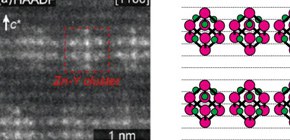
Hardening mechanisms for KUMADAI magnesium alloys elucidated through observation of their atomic vibrations
Will provide guidelines for developing lightweight and strong materials
Although Magnesium (Mg) is abundantly found in seawater and is lighter than aluminum, it has not been used as a structural material due to its soft and flammable properties.
However, Professor Yoshihito KAWAMURA at Kumamoto University and other researchers found that it was possible to create strong inflammable Mg alloys (KUMADAI Magnesium alloys) by adding zinc (Zn) and rare earth metal yttrium (Y). These Mg alloys draw attention as excellent lightweight metal materials for manufacturing bodies of subway trains and aircraft.
The excellent mechanical properties of Mg alloys are thought to be highly related to the existence of Zn6Y8 clusters. It is assumed that the impurity clusters arranged in position and direction determine the excellent properties of KUMADAI Mg alloys, but the relationship between the impurity clusters and their physical properties was unknown.
A group of researchers at Kumamoto University, together with researchers at Fukuoka University, Osaka University, and the Japan Synchrotron Radiation Research Institute, examined the impurity effects in the hardness of Mg alloys by performing inelastic x-ray scattering (IXS) experiments using X-ray radiation in KUMADAI Mg alloys containing Zn and Y impurities.
IXS and Inelastic neutron scattering (INS) measure the change in the energy of the X-ray and neutron (of a few electron volts) as they scatter from samples. This can be used to probe a wide variety of different physical phenomenon. By performing IXS measurements, information on sound waves (longitudinal and transverse), whose energy change depending on scattering angles, are obtained, through which the sound velocity of each wave is available. The hardness of material (elastic properties) can be determined by the sound wave velocity.
By adding impurities to pure Mg, impurities form almost-spherical impurity clusters, emitting inelastic scattering signals (excitations) with no dispersion. Experimental results showed that the elastic energy of the impurity clusters was very large and the hard mechanical property of KUMADAI Mg alloys was due to the strong elasticity of the impurity clusters and surrounding Mg atoms. In other words, the impurity clusters and the surrounding Mg atoms increased the strength of the Mg alloys.
This group conducted IXS experiments at the beamline BL35XU of the Synchrotron Radiation Facility SPring-8. To observe atomic vibration using X-rays, very high energy resolution is necessary. In this beamline, a very delicate technique, which utilizes the thermal expansion of the Si crystal while the temperatures of the analyzer crystals were kept unchanged within some mK, was used.
This technique will clarify the function of Mg material, whose function can be controlled by adding elements, and will give new guidelines for developing new lightweight structural materials of metallic alloys that do not contain expensive rare earth metal Y.
Currently, rare earth metal impurities, such as Y and gadolinium (Gd), are expensive. This group’s study has clarified suitable atomic arrangement of impurities to make Mg alloys attractive as structural materials. This group’s results will indicate new guidelines for exploring of Mg alloys with the same atomic arrangements to be achieved by adding cheap impurities.
Figure 1
Figure 2
Figure 3
Figure 4
Figure 5
To learn more about this research, please view the full research report entitled " Phonon excitations in a single crystal Mg 85 Zn 6 Y 9 with asynchronized long-period stacking ordered phase " at this page of Acta Materialia .
Related link

